Toshiba Portege R835: Less Ultra, More Notebook
by Dustin Sklavos on March 30, 2012 11:35 AM EST- Posted in
- Laptops
- Intel
- Toshiba
- Sandy Bridge
- Notebooks
Battery Life
Where the Toshiba Portege R835 really benefits from Sandy Bridge and excels over its predecessor is in running time on the battery. Toshiba lists the battery life for the R835 as approximately nine hours, a hurdle we were actually able to clear pretty easily at idle.
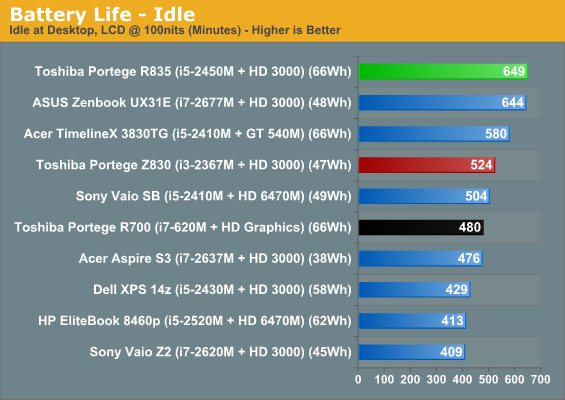
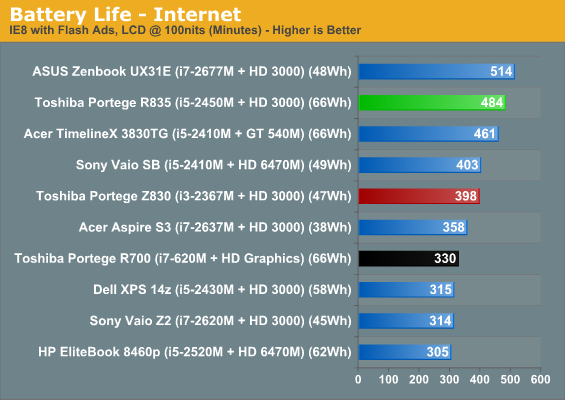
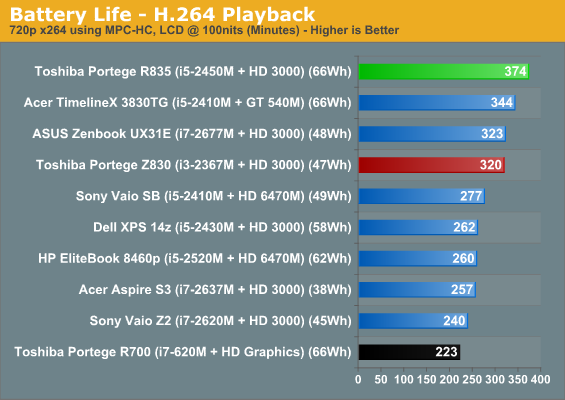
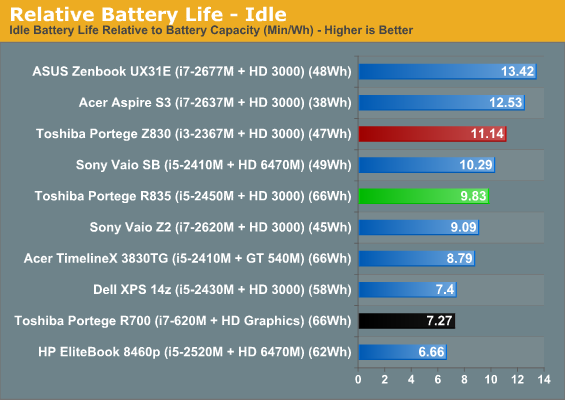
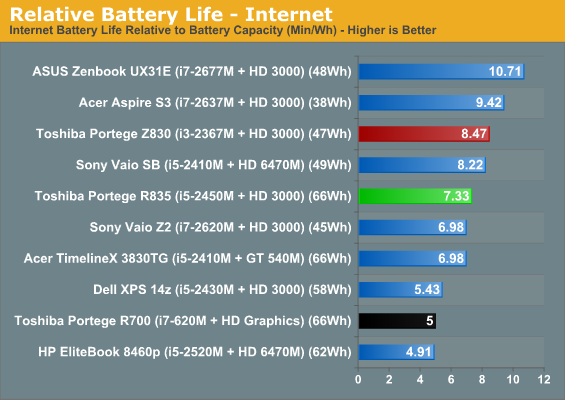
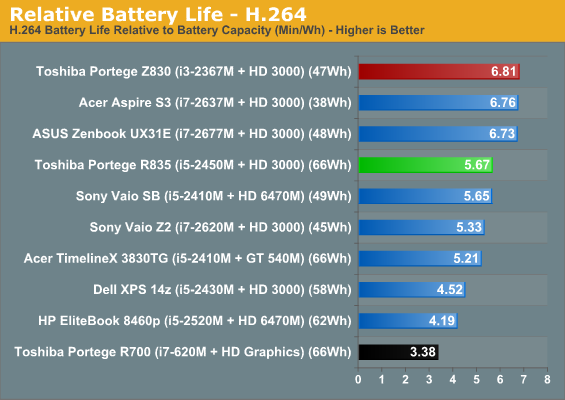
From our test results it's reasonable to assume an end user could hit that nine hour mark if they're willing to sacrifice some display brightness, or if they turn off the wireless once in a while. The Portege R835 also again demonstrates something we've been aware of for a while now: Sandy Bridge is just plain more power efficient than Arrandale. Given we're essentially looking at an updated R700, Sandy Bridge vs. Arrandale ends up with Sandy Bridge offering 35% more idle battery life, 47% more Internet battery life, and a massive 68% more video playback battery life. I makes us wonder how much further Intel can take things with Ivy Bridge, but we'll find out soon enough.
Heat and Noise
Fortunately, the high-pitched whine of the fan noise in many ultrabooks and particularly machines like Sony's Vaio Z2 isn't replicated in the Portege R835; Toshiba's notebook, even under heavy load, isn't actually that obtrusive.

Ignoring HWMonitor misreading the CPU model number, we can see there's a very good reason why fan noise isn't a huge issue with the Portege R835: the processor is basically cooking itself. This is a situation that's basically inexcusable and prevents me from making a recommendation full-stop. I was concerned thermals would prevent the i5-2450M from hitting its turbo clocks consistently after seeing these results, but apparently it's not an issue...the chip just runs very hot in this notebook.
While it's true modern processors take care of themselves to avoid burning out, I still can't help but feel like these kinds of thermals are a warranty call waiting to happen. Once dust starts accumulating in that fan it's going to be game over. This heat doesn't directly translate to the keyboard or the bottom surface of the notebook, but it's there and worthy of concern. Anecdotally, we've seen several older laptops that erred on the side of silence rather than cooling that developed serious issues over time—Jarred in fact just helped someone with a Core 2 Duo laptop that was shutting down and running horribly slow thanks to dust buildup. If you do buy a laptop like this, we definitely recommend regular dust cleanouts with compressed air, at least a couple times per year.










81 Comments
View All Comments
retrospooty - Friday, March 30, 2012 - link
"My aforementioned laptop IS 768p, and I can do everything you just mentioned, perfectly fine. Sure I have to scroll. That's not really a big deal to me"That is exactly why we hate it. I dont want to scroll to click "OK" or "next" on every other window when I am working. Its aweful. Its not really about scrolling to read a web-page. Its about decision boxes and or buttons you need to click to process something, apply a change or make whatever decision your app or site needs you to make and you cant see the options or button because its below the bottom of the aweful 768 line screen. AAAAAAUGH just typing it pisses me off. LOL
tim851 - Friday, March 30, 2012 - link
I have an 11" 768p laptop and I can't remember ever having to scroll for confirmation buttons. 1024x768 is the baseline for Windows 7, everything should be a-okay here.retrospooty - Saturday, March 31, 2012 - link
Its not.I deal with alot of different software, servers and IT related stuff. Its totally unlivable.
I suppose for a normal person it works.
KPOM - Sunday, April 1, 2012 - link
It's good enough in an 11.6" display, but for 13" or larger a higher resolution ought to be standard by now. Having more vertical real estate is a good thing.retrospooty - Friday, March 30, 2012 - link
"I saw the resolution was only 1366x768 on a 13.3" display and just skipped the rest."Exactly. As soon as I see that it goes straight to the no way in hell would I but it or recomend it to anyone.Total deal breaker. My freegin 4 inch phone has almost that much res.
dcianf - Friday, March 30, 2012 - link
Am I the only one seeing an iPhoto for iOS gallery on page 2?dave_the_nerd - Friday, March 30, 2012 - link
Nope.Dustin Sklavos - Friday, March 30, 2012 - link
Fixed.Colin1497 - Friday, March 30, 2012 - link
Didn't I just read an iPad review where it was discussed that chassis changes were expensive? Toshiba has been in this market for a LONG time. This is now 8 generations of product named Portege RXXX and there were Portege 2000 model (review from 2002: http://www.pcmag.com/article2/0,2817,7722,00.asp). I've owned a number of them, going back to the 2000, and it's common for them to keep a chassis and general design around for 2 hardware cycles. I wouldn't be shocked at all to see the R9xx have a bunch more changes.bji - Friday, March 30, 2012 - link
Here is how I read an Anadtech notebook review:Before reading a single word, skip immediately to the features chart on the first page. Look for the Display line item. If it says 768p, STOP. Do not read article. If it says something better, enjoy article.
Stop wasting your time reviewing notebooks with stupid display resolutions. I will not read them. Demand that vendors send you notebooks with worthwhile resolutions and refuse to review 768p notebooks.
Thank you.